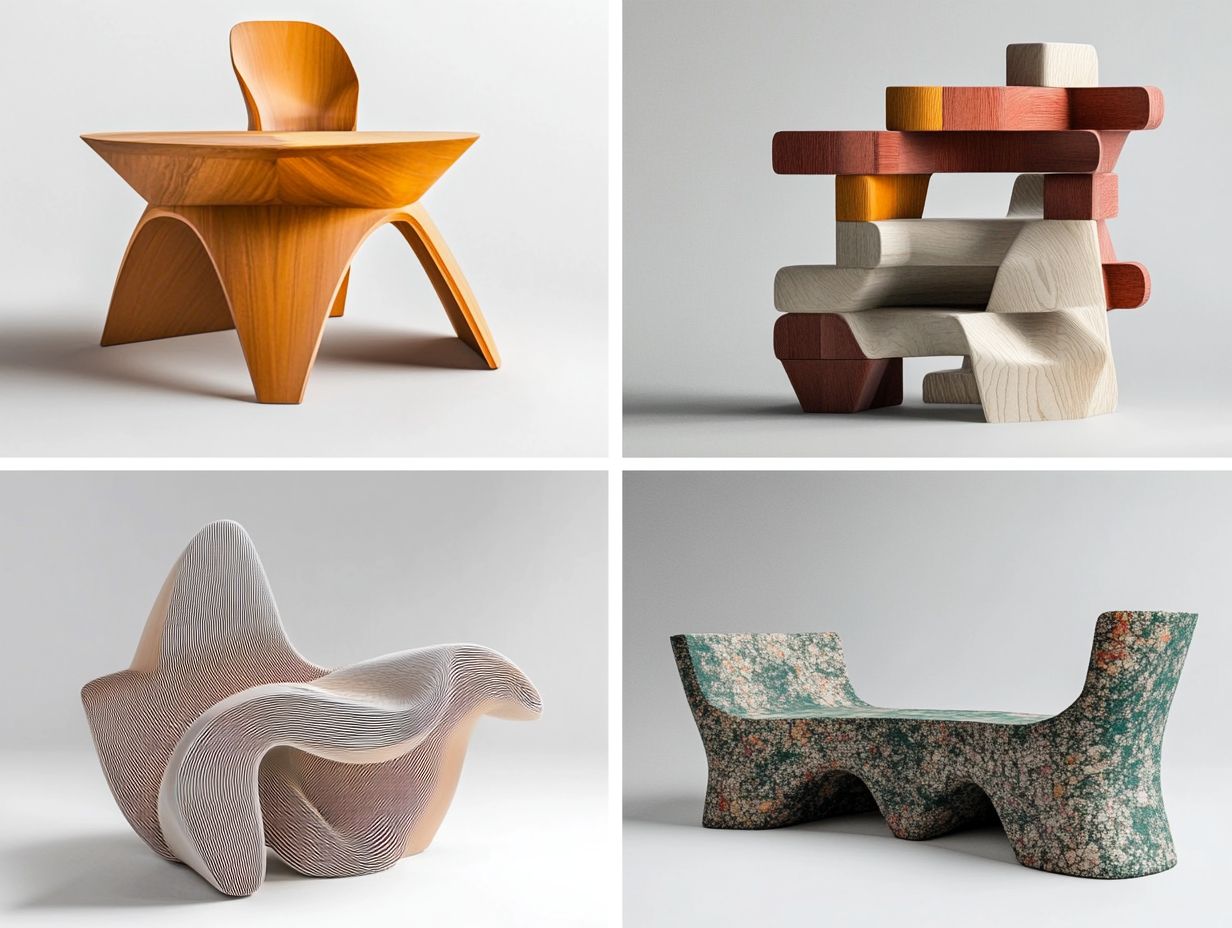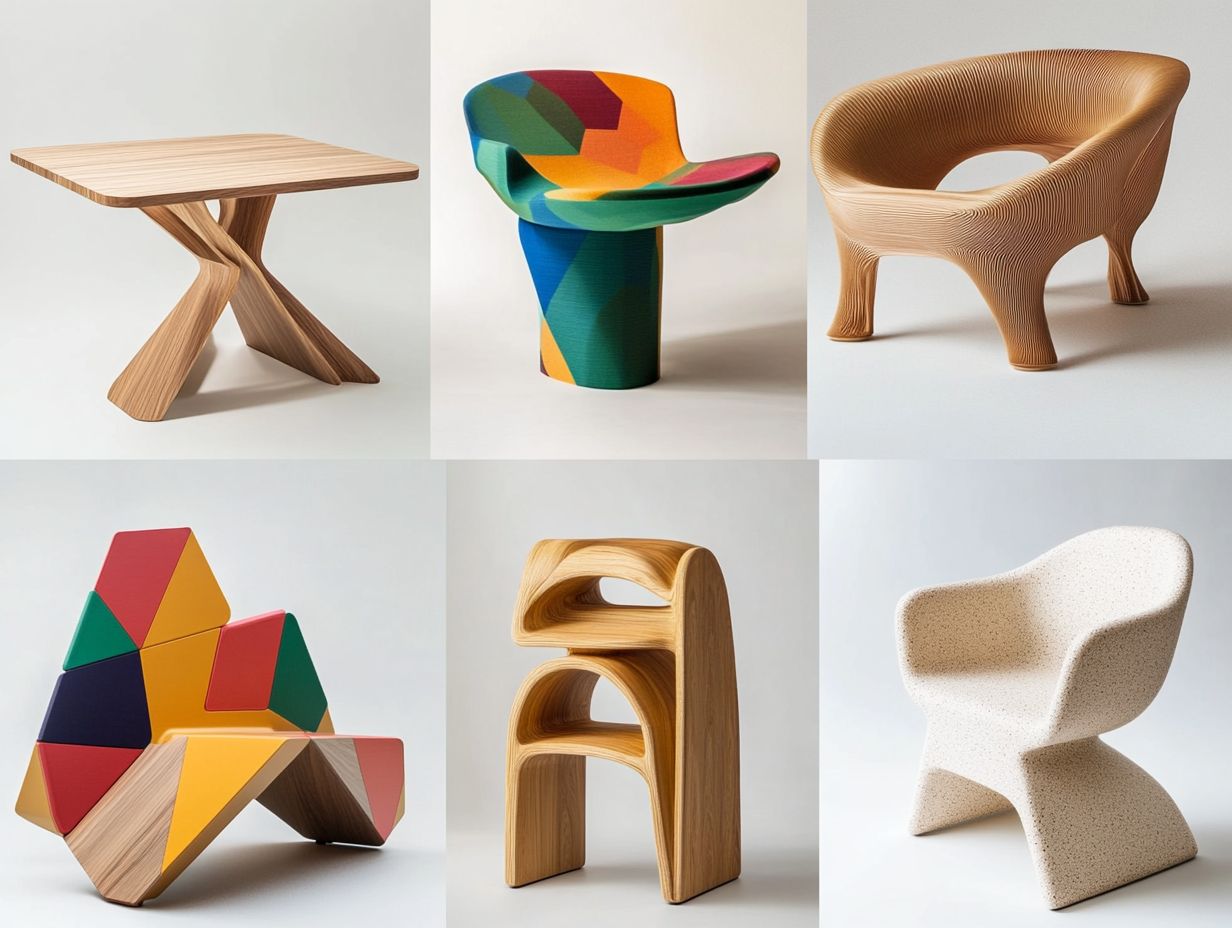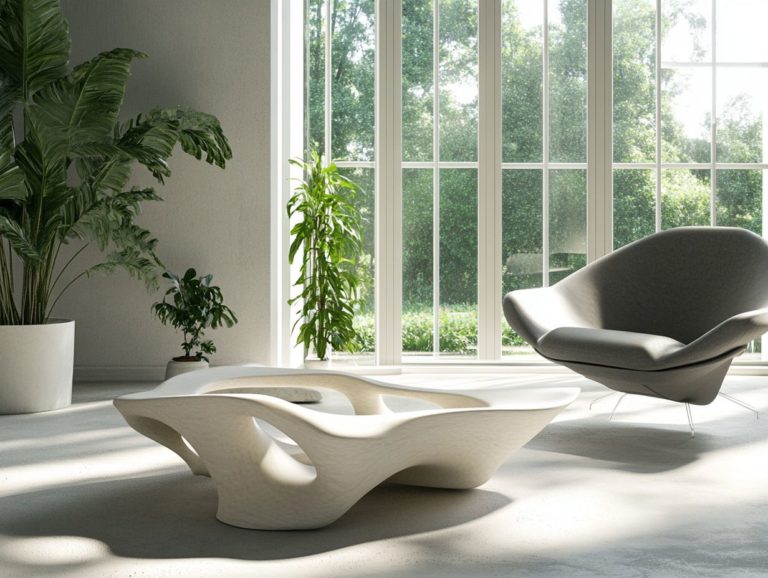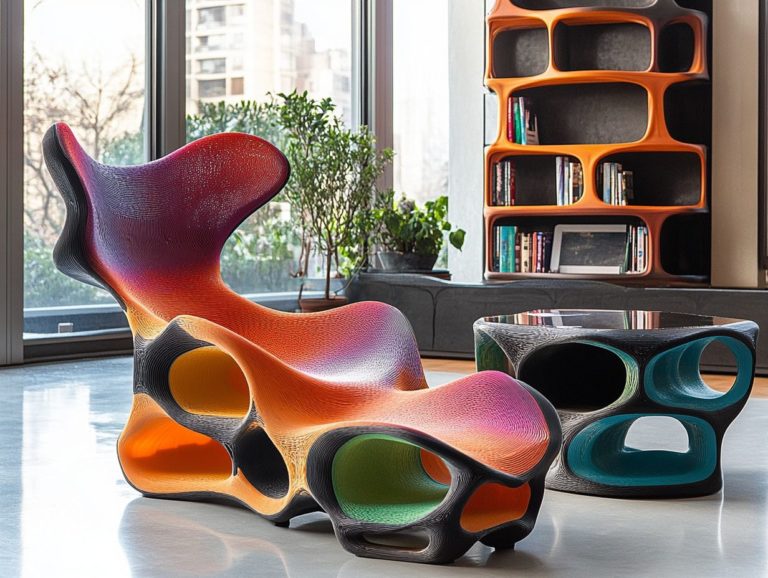5 3D-Printed Furniture Styles for Every Taste
The world of furniture design is undergoing an extraordinary transformation, all thanks to the groundbreaking technology of 3D printing.
From sleek, modern pieces to charming rustic finds, there s undoubtedly a style that speaks to your taste. This article delves into five captivating furniture styles:
- modern minimalism
- rustic vintage
- artistic uniqueness
- functional space-saving
- eco-friendly designs
Discover how 3D printing transforms your space by enhancing appearance, customization, sustainability, and functionality. Immerse yourself in the future of furniture and see how this innovative technology can elevate your living space!
Contents
- Key Takeaways:
- 1. Modern and Minimalistic
- 2. Rustic and Vintage
- 3. Artistic and Unique
- 4. Functional and Space-Saving
- 5. Eco-Friendly and Sustainable
- How Has 3D Printing Revolutionized the Furniture Industry?
- Frequently Asked Questions
- What are 5 3D-printed furniture styles for every taste?
- What is the benefit of using 3D printing for furniture?
- How does 3D printing impact sustainability in furniture design?
- Are 3D-printed furniture pieces durable?
- Can 3D-printed furniture be used in outdoor settings?
- Is 3D printing technology accessible for home use?
Key Takeaways:

- Transform your space into a modern and sleek oasis with 3D-printed furniture.
- Add character and charm to your home with rustic and vintage 3D-printed pieces.
- Make a statement with artistic and one-of-a-kind 3D-printed furniture that showcases your unique style.
1. Modern and Minimalistic
Modern and minimalistic furniture design captures the essence of sleek lines and functional beauty. It creates an atmosphere of spaciousness and elegance in your home decor. This design philosophy embraces cutting-edge 3D printing technology and material innovation, enabling architects and designers like Zaha Hadid Architects to explore creative realms once beyond reach.
By utilizing lightweight foaming bioplastics, this approach prioritizes aesthetics and sustainability. It heralds a new era in digital design and furniture creation.
These groundbreaking techniques allow for the construction of intricate geometric shapes that enhance visual appeal without compromising usability. For instance, the fluid forms of the ‘Vases’ series and the striking ‘Liquid Glacial Table’ by Zaha Hadid exemplify how advanced materials can fuse structural integrity with elegant design.
Designers are transforming everyday items like chairs and shelving systems, merging digital fabrication with comfortable design. By striking a balance between form and purpose, these contemporary creations invite you to experience art in your living spaces while thoughtfully addressing your functional needs.
2. Rustic and Vintage
Rustic and vintage furniture designs infuse your modern home with warmth and a sense of nostalgia. They are often crafted from upcycled materials and traditional techniques that create unique pieces with intriguing stories.
The integration of cutting-edge 3D printing technology into these classic styles truly revitalizes the design process. This innovation allows you to recreate intricate motifs or structural elements that maintain rustic charm while enhancing functionality.
Imagine a coffee table that marries reclaimed wood with a 3D-printed base made from marine plastics. This piece boasts a distinctive design and champions environmental sustainability. Such furniture embodies the harmonious blend of modern techniques and timeless aesthetics, appealing to those who cherish both heritage and innovation.
3. Artistic and Unique
Artistic and unique furniture pieces command attention with their bold designs and innovative forms. For those interested in exploring this creative potential, checking out the 5 best 3D-printed furniture solutions for urban living can showcase the work of designers like Philipp Aduatz.
In this exciting realm, 3D printing enables you to craft customized items that resonate with your individual tastes, ensuring that each piece serves as a personal statement. For example, the Ermis Chair features intricate floral aesthetics that seamlessly blend artistry with functionality. To discover more about the latest trends, check out 5 trends in 3D-printed furniture you should know. This chair mesmerizes with its delicate patterns and organic shapes while delivering the practicality essential for daily life.
Such designs demonstrate how modern technology can turn artistic visions into reality and allow you to enjoy a harmonious balance of beauty and utility in your living spaces.
4. Functional and Space-Saving

Functional and space-saving furniture designs are vital for urban living. They use innovative techniques like automated processes and 3D printing to enhance utility without compromising style.
In urban living, space is precious. Designers like Patrick Jouin create adaptable solutions that change functions with ease.
Consider versatile pieces such as foldable dining tables and expandable sofas. These items illustrate how modern design can conserve space while blending with your d cor.
5. Eco-Friendly and Sustainable
Eco-friendly and sustainable furniture designs are changing the industry. They focus on sustainable production methods and innovative materials like PLA, led by pioneers such as The New Raw.
This zero-waste approach reduces environmental impact. It encourages responsible consumption and manufacturing practices.
With 3D printing, designers create customizable pieces that cut down on material waste. They use resources like recycled plastics and bamboo.
Techniques like modular design enhance sustainability. Each component can be repaired or replaced, rather than thrown away.
This movement towards greener design inspires you to make conscientious choices. It nurtures a circular economy that values durability over disposability.
How Has 3D Printing Revolutionized the Furniture Industry?
3D printing is transforming the furniture industry, allowing you to create customized pieces tailored to your needs and preferences. Check out the 5 must-have 3D-printed furniture items for your home for inspiration.
This approach fuels your creativity and minimizes material waste. For instance, companies like Vitra are using 3D printing to design stunning, functional furniture.
By adopting this technology, they produce items that fit your specific dimensions. This eliminates excess materials that would usually end up in landfills.
The ability to create unique pieces is changing how you experience furniture. It’s shifting the focus from mass production to personalization.
What Are the Advantages and Disadvantages of 3D-Printed Furniture?
The advantages of 3D-printed furniture are compelling. You benefit from customization, reduced waste, and innovative designs tailored to your needs.
Imagine searching for a one-of-a-kind coffee table. With 3D printing, you can create a piece that matches your aesthetic perfectly.
This method minimizes excess material, making it more environmentally friendly. However, some bespoke items may not withstand daily use.
While the upfront costs may be higher than mass-produced alternatives, the unique craftsmanship justifies the investment for many.
What Are the Most Popular Materials Used in 3D-Printed Furniture?

When you’re exploring 3D-printed furniture, you ll find popular materials like PLA, lightweight foaming bioplastics, and upcycled materials. Each of these options brings unique properties to the table, catering to various design needs and sustainability goals.
These materials are versatile and play a key role in promoting eco-friendly practices within the furniture industry. Take PLA, for instance. It s derived from renewable resources like cornstarch and is biodegradable. This makes it a perfect choice for environmentally conscious designers.
Lightweight foaming bioplastics offer durability while minimizing material usage, effectively reducing overall waste.
Then there are upcycled materials, which breathe new life into discarded objects. They transform what would typically be trash into something artistic and sustainable. Together, these options enable you to create innovative pieces that meet aesthetic and functional demands while aligning with a greener philosophy for the future of furniture design.
How Can One Customize Their Own 3D-Printed Furniture?
Customizing your own 3D-printed furniture is an exhilarating journey! You get to select design elements, materials, and dimensions to create a piece that seamlessly fits your space and reflects your personal style. For inspiration, check out 5 popular 3D-printed furniture designers to follow.
As you embark on this adventure, use digital tools that expand your creative horizons. Advanced software tools like computer-aided design (CAD) and design software (SketchUp) enable you to visualize and refine your ideas with precision.
Pay careful attention to both ergonomics and aesthetics during the design phase. If you desire a truly exceptional touch, consider commissioning professional designers who specialize in 3D printing. You can explore platforms like Behance or Upwork to discover talented individuals eager to transform your vision into a stunning, custom-made reality.
What Are the Future Possibilities of 3D-Printed Furniture?
The future of 3D-printed furniture is bursting with exciting possibilities! From innovative designs to unique materials, there are already stylish 3D-printed furniture pieces for kids’ rooms showcasing how technological advancements are poised to unlock a realm of creative potential in production techniques.
As these innovations unfold, you may find yourself stepping into an exciting new era where sustainability becomes the cornerstone of furniture manufacturing. Now is the time to embrace eco-friendly materials and minimize waste. This could significantly reduce the industry’s carbon footprint, making a positive impact on the environment.
Expect advancements in aesthetics to allow for highly customizable pieces tailored to your individual tastes, seamlessly blending form and function. Functionality will also undergo a revolution, as smart furniture incorporating technology becomes more common, offering you interactive experiences that elevate your living spaces to new heights.
How Can 3D-Printed Furniture Benefit the Environment?
3D-printed furniture offers remarkable benefits for the environment! It promotes sustainable production practices, utilizes upcycled materials, and embraces a zero-waste philosophy to minimize the ecological footprint of furniture manufacturing.
This innovative approach enables you to create custom pieces that perfectly suit your needs while significantly reducing excess inventory and material waste. Brands like IKEA, in collaboration with local artisans, and startups such as Ecodesign, harness 3D printing technology to design stylish, eco-friendly furniture crafted from recycled plastics.
By integrating sustainable practices into their operations, these companies demonstrate how 3D printing can seamlessly blend aesthetic appeal with ecological responsibility. Ultimately, this paves the way for a more conscientious and sustainable approach to interior design and production.
Frequently Asked Questions

What are 5 3D-printed furniture styles for every taste?
The 5 stylish 3D-printed furniture solutions for your home cater to every taste, including modern, rustic, industrial, minimalist, and futuristic styles.
What is the benefit of using 3D printing for furniture?
3D printing allows for unique, customizable furniture, offering 5 customizable 3D-printed furniture ideas that you can create tailored to your individual style and needs.
How does 3D printing impact sustainability in furniture design?
3D printing greatly cuts down on waste. It uses only the materials needed and can lower transportation costs.
Are 3D-printed furniture pieces durable?
Yes, 3D-printed furniture can be as durable as traditional pieces. This depends on high-quality materials and solid design.
Can 3D-printed furniture be used in outdoor settings?
Yes! There are designs specifically made for the outdoors. These pieces use durable, weather-resistant materials.
Is 3D printing technology accessible for home use?
Absolutely! Affordable, user-friendly 3D printers are now available for home use. This means you can create your own furniture!






